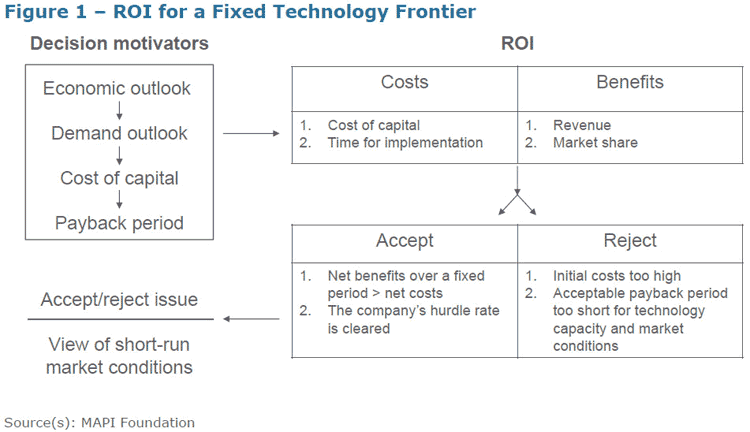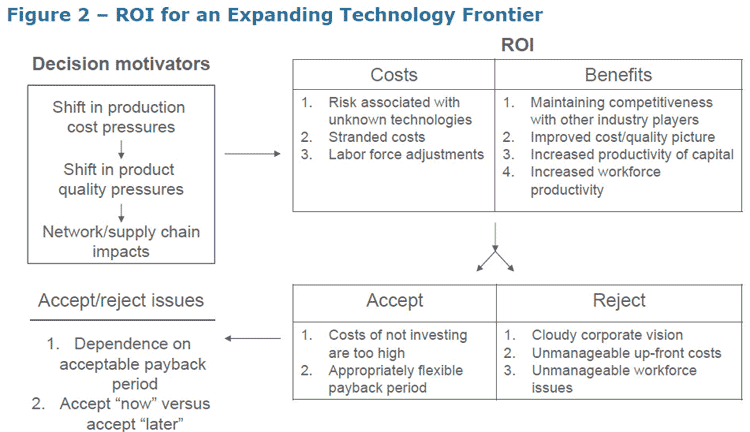How do manufacturing companies make decisions about whether to invest in new equipment and automation?
It turns out there has been decades of research on this seemingly straight forward issue, one of the latest of which explores the difference in analysis between proven technologies and equipment and systems that are new to the firm, or maybe even to the industry.
Supply Chain Digest Says... |
|
|
A recent report by Cliff Waldman of MAPI – The Manufacturing Alliance explores those differences in some detail. While definitely coming at the subject in what fairly can be called an academic tone, the paper nevertheless offers some interesting insights into how companies should consider such investments.
Proven technologies and equipment that a given company already has experience with, are generally adopted based on some basic variables. There is not a lot of mystery about the costs or the financial benefits because experienced has shed much detail as to what those financial buckets will be, MAPI says.
But even so, just how much capital stock a given manufacturer should have is not obvious at any point in time, and is dynamic over time.
How much capital stock to have is a question that manufacturing business executives confront almost daily, MAPI says.
The many variables that enter into consideration of the optimal capital stock for any company include "the economic outlook, current and future demand for the company's output, changing industry conditions, and policy and market variables (taxes, regulations, interest rates, the state of technological advancement, etc.)," MAPI observes.
What's more, assessing many of these variables requires engaging in the error-prone process of developing a forecast of demand.
There have been many theories developed about how executives should frame should frame this decision, including the "accelerator mode" that posits that investment derives from the simple principle that a company desires a fixed capital to output ratio. In other words, as sales grow, capital stock will rise in lock step.
There are others decision models, the most common of which is of course return on investment, or ROI. The concept is known to virtually all supply chain professionals, but is described by MAPI using the following equation:
ROI (Est) = (B(Est)-C(Est))/C(Est)
Where B(Est) = Benefits expected from project implementation over a given period of time
C(Est) = Financial and non-financial costs of project implementation
The only thing perhaps somewhat different than how many companies think about ROI is the inclusion of "non-financial costs" as part of the formula. Not all companies attempt to estimate to those other costs.
"The advantage of the ROI tool is its conceptual simplicity, which allows for easy comparisons between and among investment projects," MAPI notes. "The challenges and the drawbacks relate to the considerable difficulty of estimating benefits and costs. Even small errors, which can certainly be expected when forecasting a range of costs and benefits, can have large implications for project assessment."
However, MAPI says, the cost and benefit estimates are likely to be far more accurate for mature technologies and systems than they are for equipment that the firm has little experience with, and indeed may be fairly new to the market.
Importantly, the drivers of investment in new technologies are usually far different than that for proven systems.
"New technology investment is unlikely to be a reaction to changes in the reality or the expectations for the short-term economic environment," MAPI says. "There is a larger and more complex set of factors at work, related in part to changing fundamental cost pressures, other types of globalization market pressures, and industry-specific conditions."
(Article Continued Below)
|
CATEGORY SPONSOR: SOFTEON |
|
|
| |
|
|
What's more, at any point in time, the choice being made is often not a choice between adopting and not adopting but rather between adopting now or deferring the decision until later. That's because the benefits from adopting a new technology are received throughout the life of the investment while the costs are up-front and generally unrecoverable if the investment does not work out.
"Such a decision space creates an option value to waiting," MAPI observes. In other words, waiting means the costs and benefits of new technology will be better understood with the passage of time.
The result of all this is what economists call the "S curve" effect for new technology if one plots the number of users of a new product or invention is against time. Adoption is slow at first, accelerates as it spreads throughout the pool of potential adopters, and then slows as the relevant population becomes saturated.
MAPI also presents two models for maligning manufacturing investment decision, one for proven technologies, and another for new technologies and systems.
As shown in the graphic below, the drivers of capital spending under a fixed technology scenario are short-term economic dynamics, primarily the economic and product demand outlook, the cost of capital, and the desired payback period for the new capital asset(s). These drivers feed into an ROI metric where the key costs are the financial cost of capital and the time cost of capital asset implementation, the latter being a relatively straightforward matter under a scenario where technology does not change. The benefit side of the equation consists of the revenues generated by new capital assets and the maintenance or the increase in market share.

MAPI notes that acceptance of the project under the constant technology scenario would occur if the net benefits over a desired period are greater than the net costs. Conversely, rejection might come from too high initial costs of capital and implementation and too short of an acceptable payback period for the capital asset. Key issues for the accept/reject decision line come simply from shifting views of short-term market conditions.
The model for new technologies is different. As seen in the graphic below, the drivers of new technology investment aren't short-term shifts in market conditions but rather long-term changes in business pressures. Such factors include marked changes in production costs and product quality pressures, as well as the spreading of the new technology through the industry and/or supply chain, which could put a company not adopting it at a disadvantage.

With new technology investment, the cost side of the ROI equation contains a larger and broader set of factors than is the case with a mature technology. They include a set of risks associated with a technology for which there is below-average knowledge regarding capabilities. And the supply chain transformations that are often needed for incorporation of the new technology amplify the unknown.t Think for example of the transformation need to go from very manual t very automated manufacturing operations.
These include the unrecoverable stranded costs of old technologies that must be discarded as production adapts to a new technology, as well as the often difficult labor force adjustments that are needed in the wake of a technological shock to production (meaning layoffs).
However, the benefits of a new technology investment are potentially as broad as the costs. For instance, the failure to invest when the technology is working its way into the industry production structure would mean potentially large opportunity costs of not being fully competitive. Thus, investment of the technology in question has the benefit of competitive parity. There are also the broad benefits of an improved production cost / product quality picture as well as the increased productivity of capital and the potential increase in workforce productivity over time.
While the accept/reject function is complex, it is certainly the case that if the costs of not investing in the new technology are too high and if the company has an appropriately flexible concept of the "acceptable" payback period for the new capital asset, impetus for acceptance is strong.
SCDigest will note here that it is generally accepted that European companies tend to be comfortable wih longer payback periods from automation than do US firms, leading to greater adoptioon rates.
Rejection of new technology "might come from uncertainty over the long-run path of the company itself, which would certainly cloud the complex decision over a new technology investment," MAPI says. "Or rejection might come more fundamentally from unmanageable initial capital and implementation costs or workforce issues deemed to be insurmountable, at least at the time of the decision."
Despite the risks, MAPI says the potential additional value from the benefit side from new technologies is often compelling.
"While early adopters can establish differentiation, the often observed spreading effect of new technologies means that eventually most companies will likely need to engage in the implementation of the increasingly used new technology to maintain production cost competitiveness," MAPI concludes. "For the holdouts there is certainly a wait-and-see option. But with successful new technologies, waiting might become increasingly costly. The more direct quantifiable benefits are potential improvements in the productivity of capital, product quality, and supply chain efficiency, to name a few."
The full MAPI report can be flound here: Decision Criteria for New Technology Investment
What's your reaction to MAPI's models of manufacturing investment? What would you add to the discussion? Let us know your thoughts at the Feedback section below.
Your Comments/Feedback
|